1973 CHEVROLET MONTE CARLO window
[x] Cancel search: windowPage 5 of 86

Downloaded from www.Manualslib.com manuals search engine BEFORE DRIVING YOUR MONTE CARLO
DRIVER CHECKLIST
Before Entering Car
1. See that windows , mirrors and
lights are clean.
2 . Visually note inflation condition
of tires.
3. Check that area to rear is clear
if about to back up.
Before Driving Off
1. Lock all doors.
2. Position seat and adjust head
restraints.
3. Adjust inside and outside mir
rors.
4 . Fasten seat belts.
5. Check that warning bulbs light
when key
is turned to start posi
tion.
6 . Release parking brake (and see
that brake warning light turns
off). 7
. Be sure you understand your
car and how to operate it safely.
Keys
Two separate keys are provided
for your car. Each key has a differ
ent cross section so that it can be
inserted only
in certain locks.
• Key with square head
(stamped "E") -for ignition
switch and door locks.
• Key with oval head (stamped
"H") -for all other locks.
fib
~ ALL OTHER LOCKS
3
The code number of each key is
stamped on the "knock out" plug
in the key head. Your Chevrolet
dealer removed these plugs and
placed them with the spare set of
keys in the special key envelope
that was given to you at time of
delivery. For your protection:
• Record the numbers on the key
envelope and discard the key
plugs.
• Keep the key envelope in a safe
place such
as your wallet, Not
In The Car.
In the event the original keys are
lost, duplicates can be made by
your dealer or a locksmith using
the key code information.
Be sure to lock the glove box or
console compartments and remove
the key from the car whenever it
is
necessary to leave the ignition key
with an attendant.
Page 7 of 86
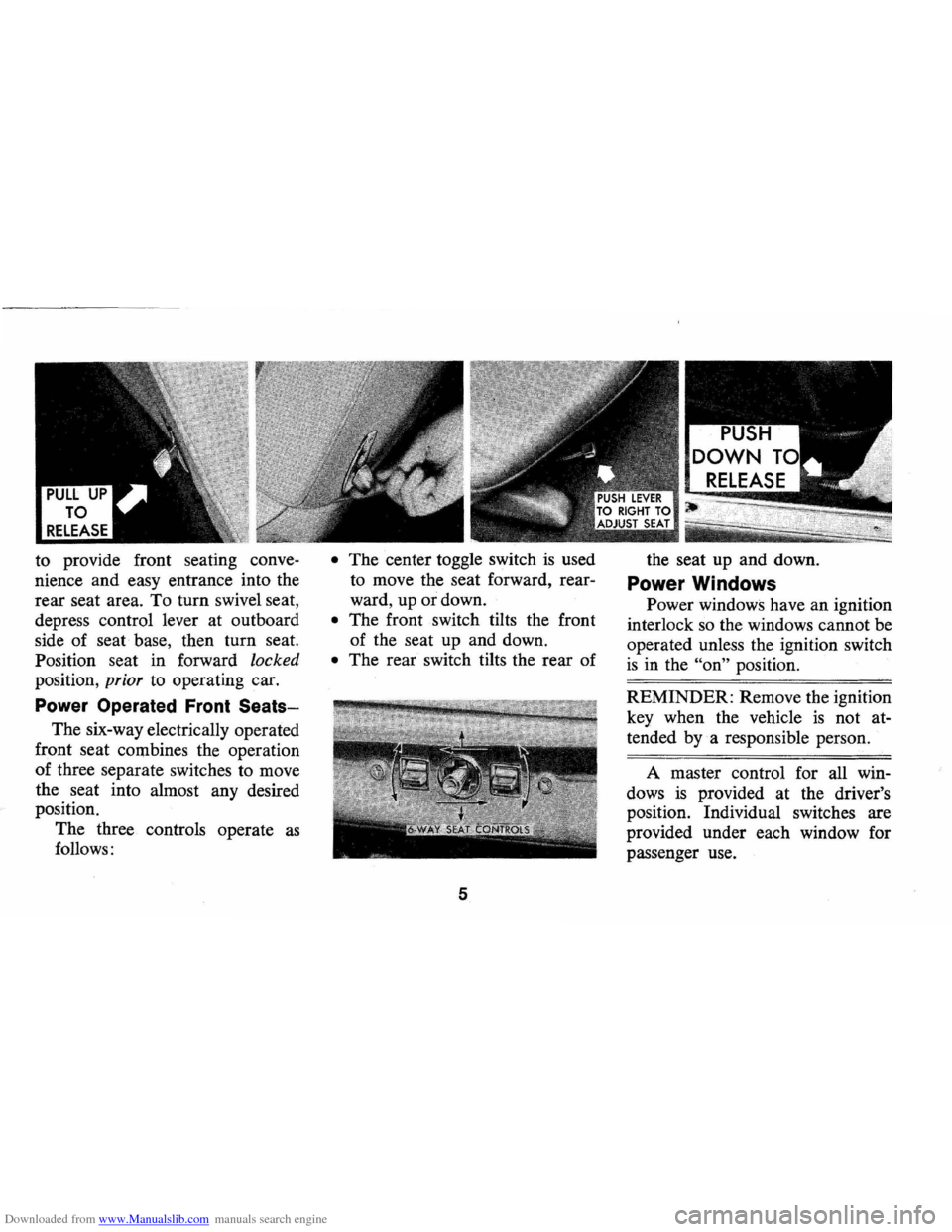
Downloaded from www.Manualslib.com manuals search engine to provide front seating conve
nience and easy entrance into the
rear seat area. To turn swivel seat,
depress control lever at outboard
side of seat base, then turn seat.
Position seat in forward
locked
position, prior to operating car.
Power Operated Front Seats-
The six-way electrically operated
front seat combines the operation
of three separate switches to move
the seat into almost any desired
position.
The three controls operate
as
follows:
• The center toggle switch is used
to move the seat forward, rear
ward, up or down.
• The front switch tilts the front
of the seat up and down.
• The rear switch tilts the rear of
5
the seat up and down.
Power Windows
Power windows have an ignition
interlock so the windows cannot be
operated unless the ignition switch
is in the "on" position.
REMINDER: Remove the ignition
key when the vehicle
is not at
tended
bya responsible person.
A master control for all win
dows
is provided at the driver's
position. Individual switches are
provided under each window for
passenger use.
Page 9 of 86
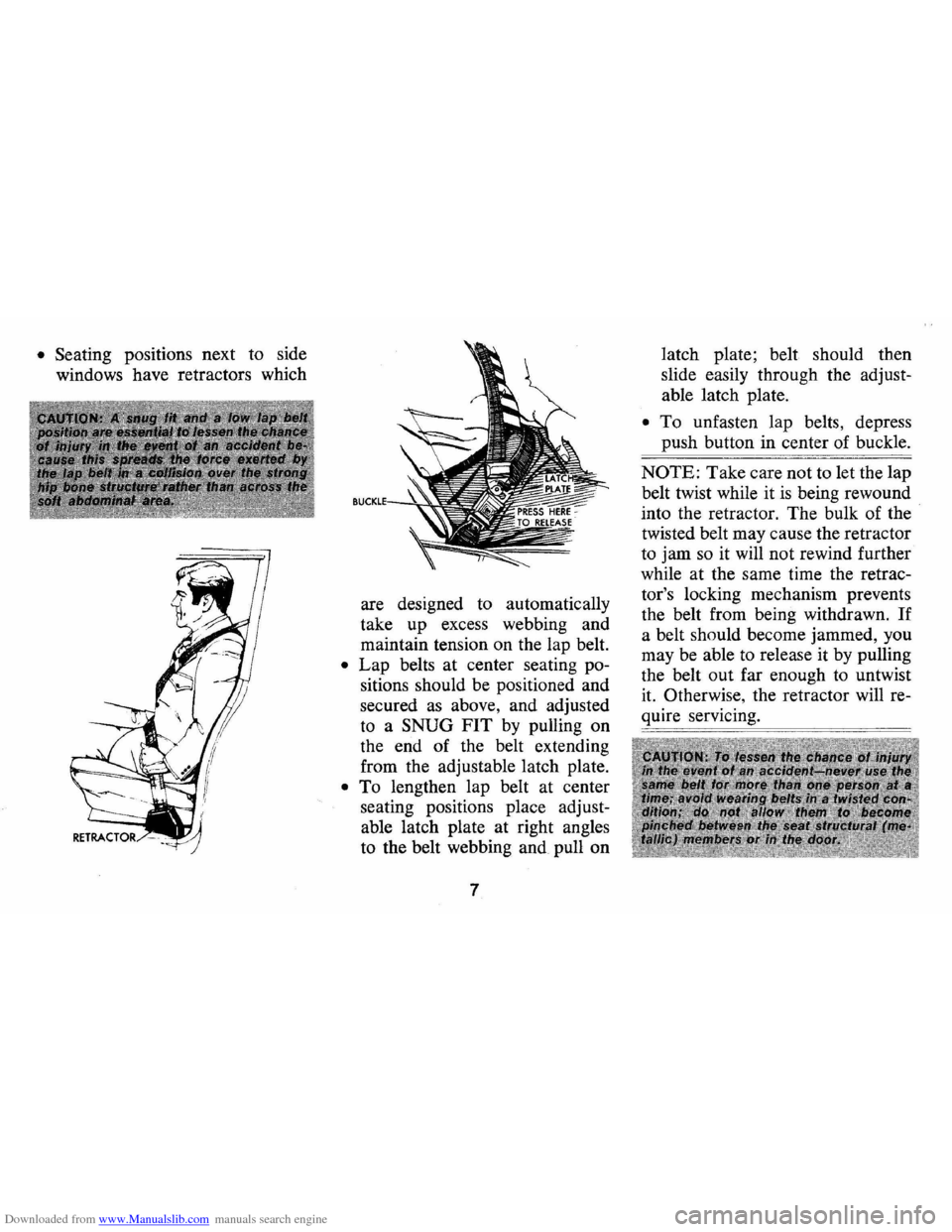
Downloaded from www.Manualslib.com manuals search engine • Seating positions next to side
windows have retractors which
are designed to automatically
take up excess webbing and
maintain tension on the lap belt.
• Lap belts at center seating po
sitions should be positioned and
secured as above, and adjusted
to a SNUG FIT by pulling on
the end of the belt extending
from the adjustable latch plate.
• To lengthen lap belt at center
seating positions place adjust
able latch plate at right angles
to the belt webbing and pull on
7 latch
plate; belt should then
slide easily through the adjust
able latch plate.
• To unfasten lap belts, depress
push button in center of buckle.
NOTE: Take care not to let the lap
belt twist while it
is being rewound
into the retractor. The bulk of the
twisted belt may cause the retractor
to jam so it will not rewind further
while at the same time the retrac
tor's locking mechanism prevents
the belt from being withdrawn.
If
a belt should become jammed, you
may be able to release it by pulling
the belt out far enough to untwist
it. Otherwise, the retractor will re
quire servicing.
Page 10 of 86
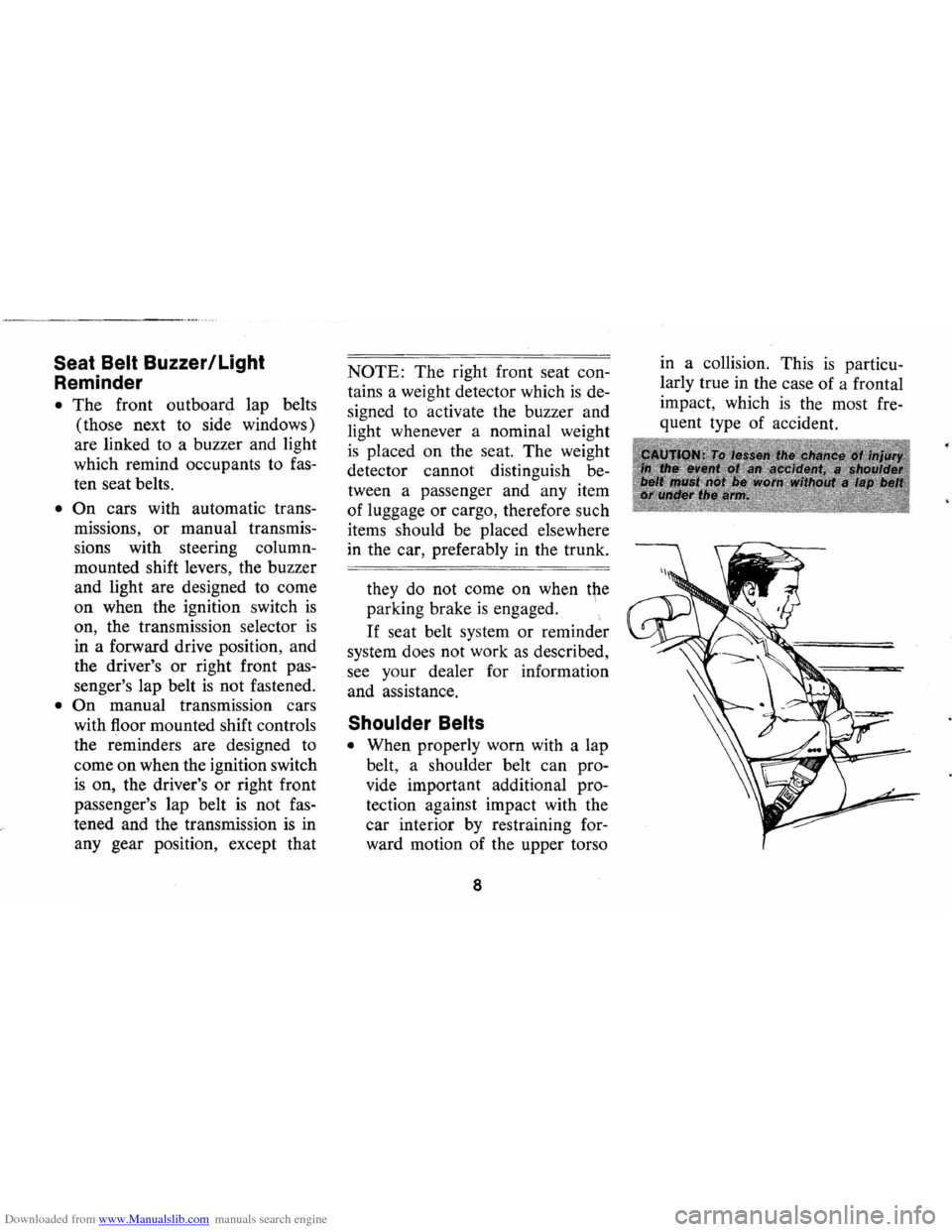
Downloaded from www.Manualslib.com manuals search engine Seat Belt Buzzer/Light
Reminder
• The front outboard lap belts
(those next to side windows)
are linked to a buzzer and light
which remind occupants to
fas
ten seat belts.
• On cars with automatic trans
missions, or manual transmis
sions with steering column
mounted shift levers , the buzzer
and light are designed to come
on when the ignition switch
is
on, the transmission selector is
in a forward drive position, and
the driver's or right front pas
senger's lap belt
is not fastened.
• On manual transmission cars
with floor mounted shift controls
the reminders are designed to
come on when the ignition switch
is on, the driver's or right front
passenger's lap belt
is not fas
tened and the transmission
is in
any gear position, except that
NOTE: The right front seat con
tains a weight detector which
is de
signed to activate the buzzer and
light whenever a nominal weight
is placed on the seat. The weight
detector cannot distinguish be
tween a passenger and any item
of luggage or cargo, therefore such
items should be placed elsewhere
in the car, preferably
in the trunk.
they do not come on when
t~e
parking brake is engaged.
If seat belt system or reminder
system does not work
as described,
see your dealer for information
and assistance.
Shoulder Belts
• When properly worn with a lap
belt, a shoulder belt can pro
vide . important additional pro
tection against impact with the
car interior
by restraining for
ward motion of the upper torso
8
in a collision. This is particu
larly true in the case of a frontal
impact, which
is the most fre
quent type of accident.
Page 13 of 86
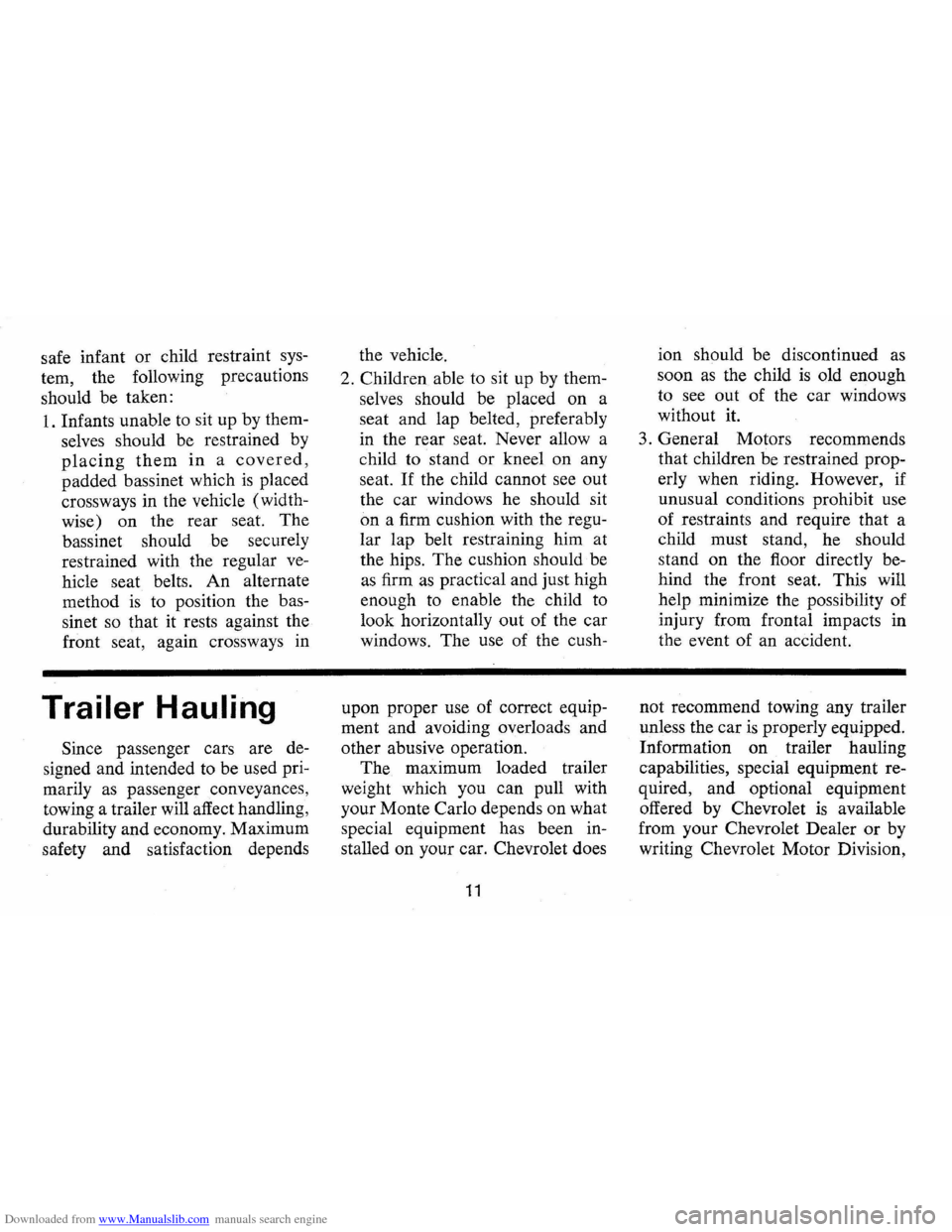
Downloaded from www.Manualslib.com manuals search engine safe infant or child restraint sys
tem, the following precautions
should be taken:
1. Infants unable to sit up by them
selves should be restrained by
placing them in a covered,
padded bassinet which is placed
crossways in the vehicle (width
wise) on the rear seat. The
bassinet should be securely
restrained with the regular
ve
hicle seat belts. An alternate
method
is to position the bas
sinet so that it rests against the
front seat, again crossways in
Trailer Hauling
Since passenger cars are de
signed and intended to be used pri
marily as passenger conveyances,
towing a trailer will affect handling,
durability
and economy. Maximum
safety and satisfaction depends the
vehicle.
2. Children able to sit up by them
selves should be placed on a
seat and lap belted, preferably
in the rear seat. Never allow a
child to stand
or kneel on any
seat.
If the child cannot see out
the car windows he should sit
on a firm cushion with the regu
lar lap belt restraining him at
the hips. The cushion should be
as firm as practical and just high
enough to enable the child to
look horizontally out of the car
windows. The use of the cush-
upon proper use of correct equip
ment and avoiding overloads and
other abusive operation.
The maximum loaded trailer
weight which you can pull with
your Monte Carlo depends on what
special equipment has been in
stalled on your car. Chevrolet does
11
ion should be discontinued as
soon as the child is old enough
to see out of the car windows
without it.
3. General Motors recommends
that children be restrained prop
erly when riding. However, if
unusual conditions prohibit use
of restraints and require that a
child must stand, he should
stand on the floor directly be
hind the front seat. This will
help minimize the possibility of
injury from frontal impacts
III
the event of an accident.
not recommend towing any trailer
unless the car
is properly equipped.
Information on trailer hauling
capabilities, special equipment re
quired, and optional equipment
offered by Chevrolet
is available
from your Chevrolet Dealer
or by
writing Chevrolet Motor Division,
Page 16 of 86
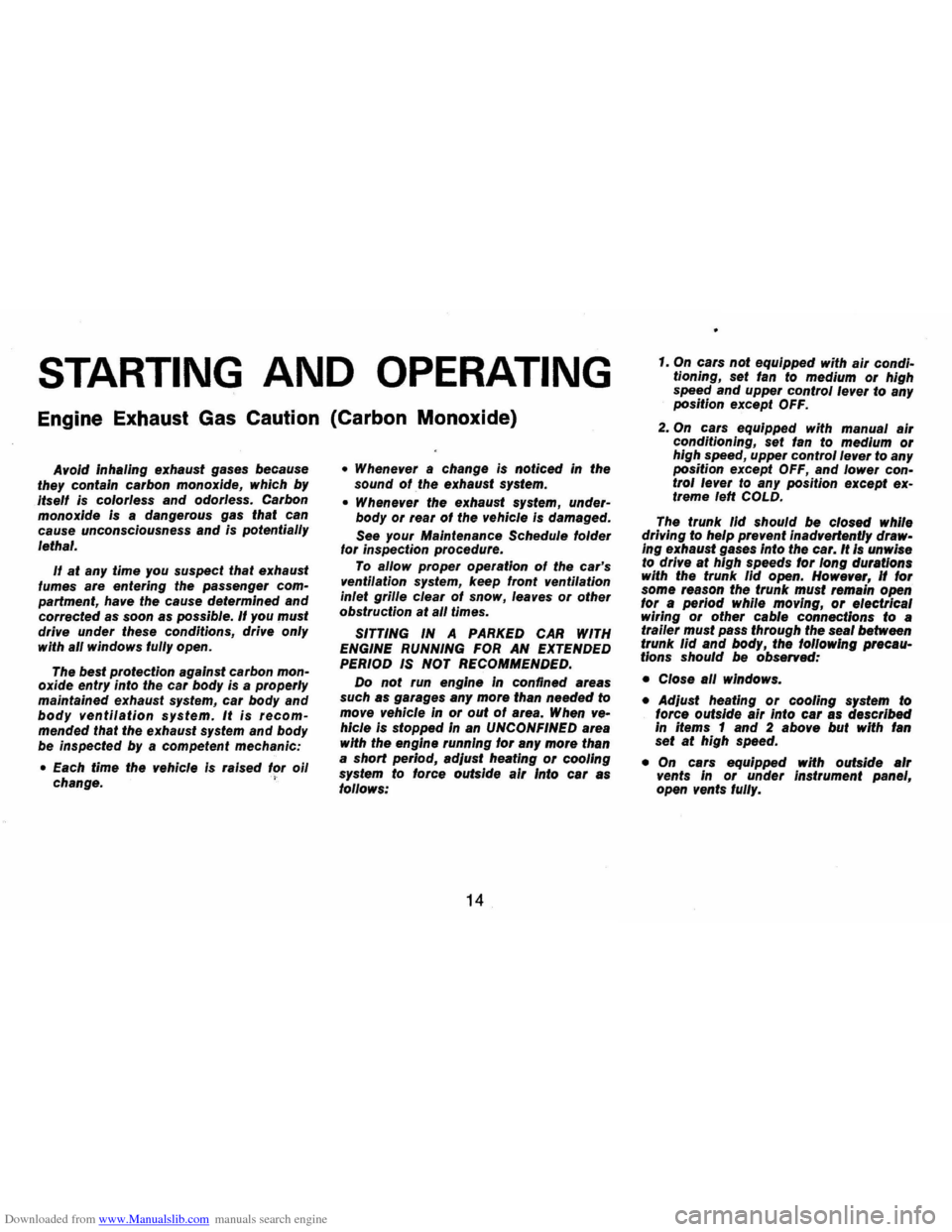
Downloaded from www.Manualslib.com manuals search engine STARTING AND OPERATING
Engine Exhaust Gas Caution (Carbon Monoxide)
Allold inhaling exhaust gases because
they contain carbon monoxide, which by
Itsell is colorless and odorless. Carbon
monoxide is a dangerous gas that can cause unconsciousness and is potentially
lethal.
II at any time you suspect that exhaust fumes are entering the passenger compartment, have the cause determined and corrected as soon as possible. II you must
drive under these conditions, drive only
with
all windows fully open.
The best protection against carbon
monoxide entry into the car body is a properly
maintained exhaust system, car body and body ventilation system. It is recommended that the exhaust system and body
be inspected by a competent mechanic:
• Each time the IIehicie is raised for oil change. > •
Wheneller a change
is noticed In the
sound of the exhaust system.
• Wheneller the exhaust system, under
body or rear of the vehicle is damaged.
See your Maintenance Schedule folder
for inspection procedure.
To allow proper operation of the car's
IIentilation system, keep front ventilation
inlet
grille clear of snow, leaves or other obstruction at all times.
SITTING IN A PARKED CAR WITH
ENGINE RUNNING FOR AN EXTENDED PERIOD IS NOT RECOMMENDED.
Do
not run engine in confined areas such as garages any more than needed to mOlle IIehicle In or out of area. When IIehlcle is stopped In an UNCONFINED area with the engine running for any more than a short period, adJust heating or cooling system to force outside air Into car as follows:
14
1. On cars not equipped with air condi
tioning, set fan to medium or high
speed and upper control leller to any
position except OFF.
2. On cars equipped with manual air conditioning, set fan to medium or high speed, upper control lever to any
position except OFF, and lower control lever to any position except extreme left COLD.
The trunk lid should be closed while
drilling to help prellent inadllertently drawIng exhaust gases Into the car. If Is unwise to drive at high speeds for long durations
with the trunk lid open. Howeller, If lor some reason the trunk must remain open lor a period while mOiling, or electrical wiring or other cable connections to a trailer must pass through the seal between
trunk lid and body, the lol/owlng precau
tions should be observed:
• Close all windows.
• Ad/ust heating or cooling system to
force outside air into car as described In items 1 and 2 abolle but with Ian set at high speed.
• On cars equipped with outside aIr IIents In or under Instrument panel, open IIents lully.
Page 27 of 86
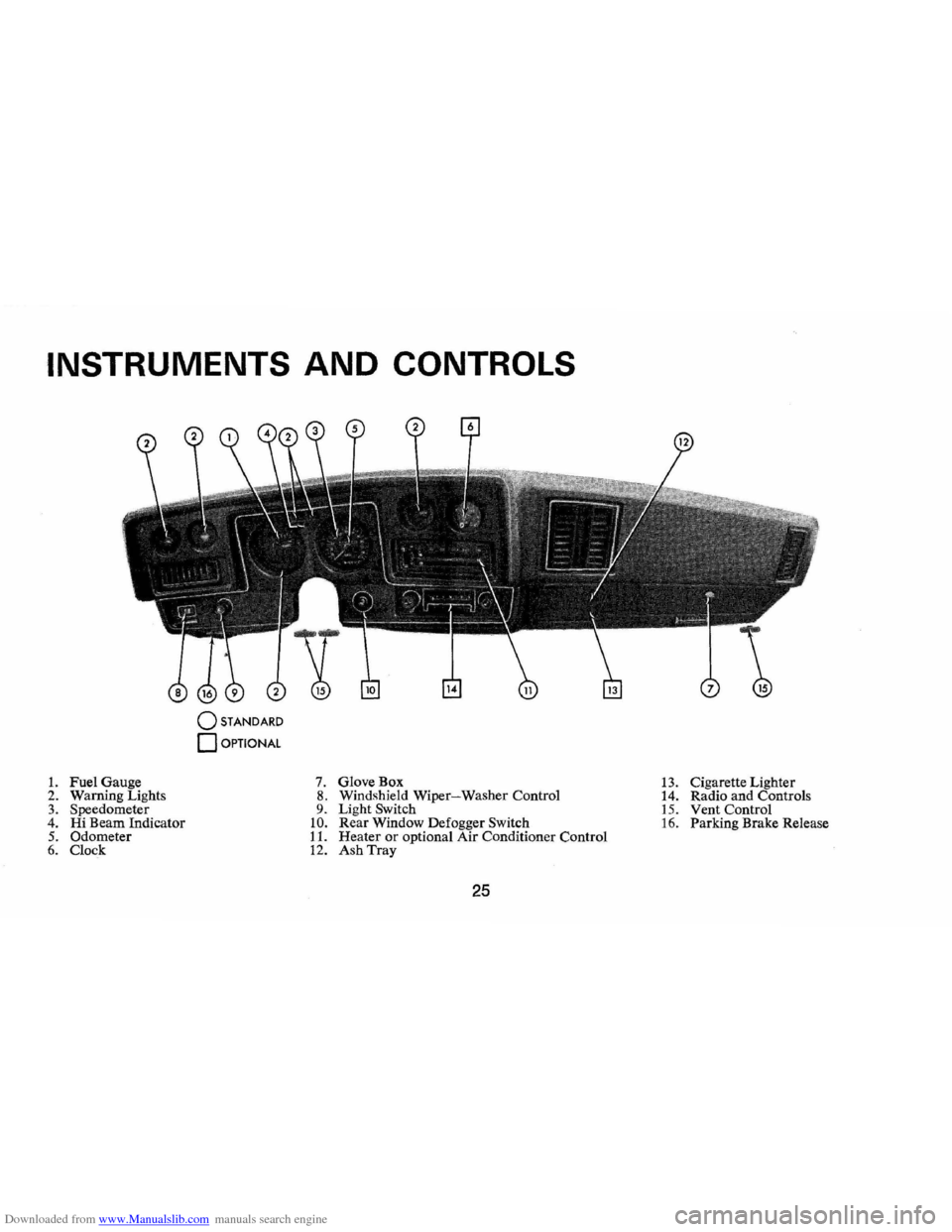
Downloaded from www.Manualslib.com manuals search engine INSTRUMENTS AND CONTROLS
o STANDARD
o OPTIONAL
1. Fuel Gauge 7. GloveBox 13. Cigarette Lighter
2. Warn ing Lights 8. Windshield Wiper-Washer Control
14. Radio and Controls 3. Speedometer 9. Light Switch 15. Vent Control 4. Hi Beam Indicator 10. Rear Window Defogger Switch 16. Parking Brake Release 5. Odometer 11. Heater or optional Air Conditioner Control 6. Clock 12. Ash Tray
25
Page 34 of 86
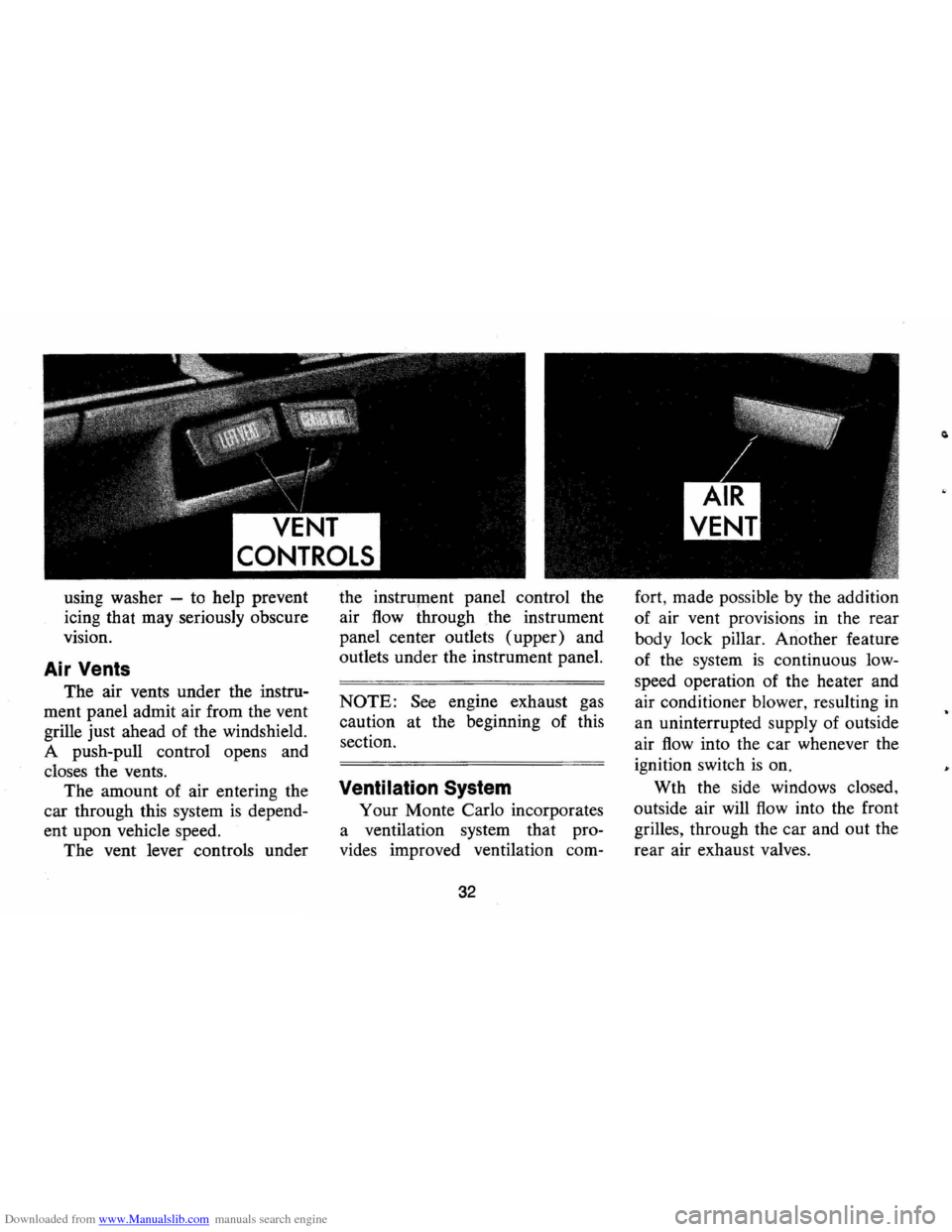
Downloaded from www.Manualslib.com manuals search engine VENT
CONTROLS
using washer -to help prevent
icing that may seriously obscure
vision.
Air Vents
The air vents under the instru
ment panel admit air from the vent
grille just ahead of the windshield.
A push-pull control opens and
closes the vents.
The amount of air entering the
car through this system
is depend
ent upon vehicle speed.
The vent lever controls under the
instrument panel control the
air
flow through the instrument
panel center outlets (upper) and
outlets under the instrument panel.
NOTE: See engine exhaust gas
caution at the beginning of this
section.
Ventilation System
Your Monte Carlo incorporates
a ventilation system that pro
vides improved ventilation com-
32
fort, made possible by the addition
of air vent provisions in the rear
body lock pillar. Another feature
of the system
is continuous low
speed operation of the heater and
air conditioner blower, resulting
in
an uninterrupted supply of outside
air
flow into the car whenever the
ignition switch
is on.
Wth the side windows closed,
outside air will
flow into the front
grilles, through the car and out the
rear air exhaust valves.